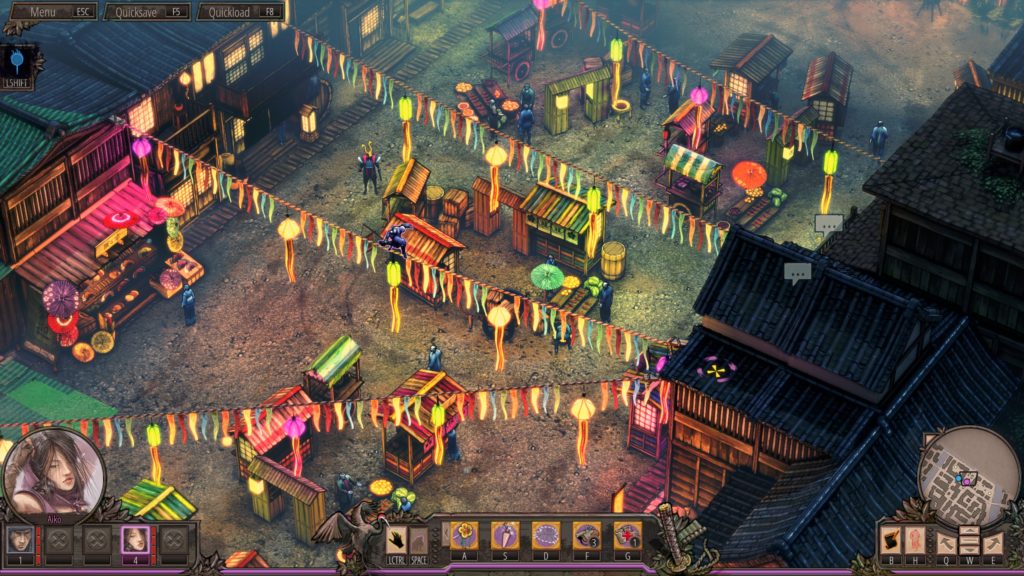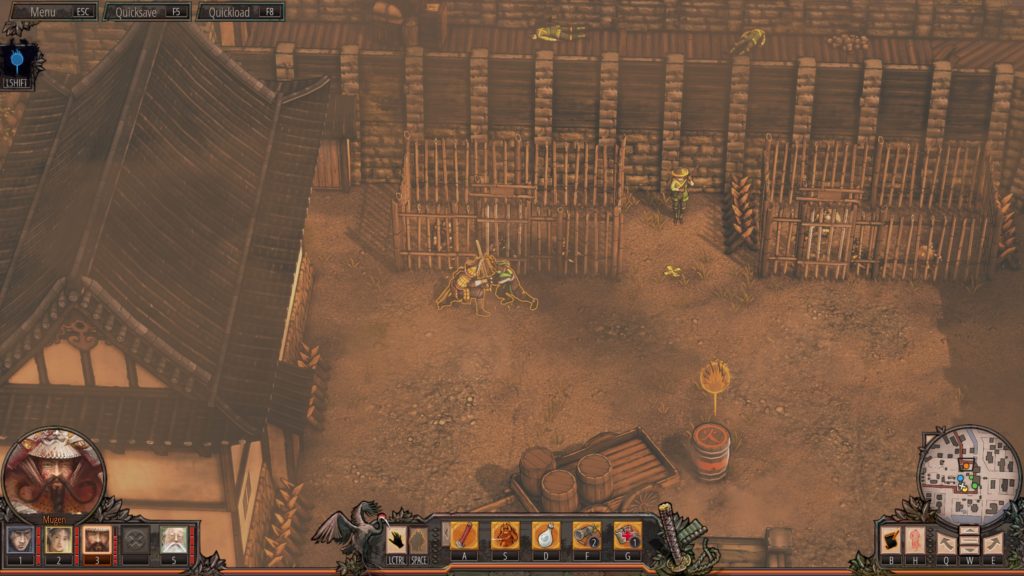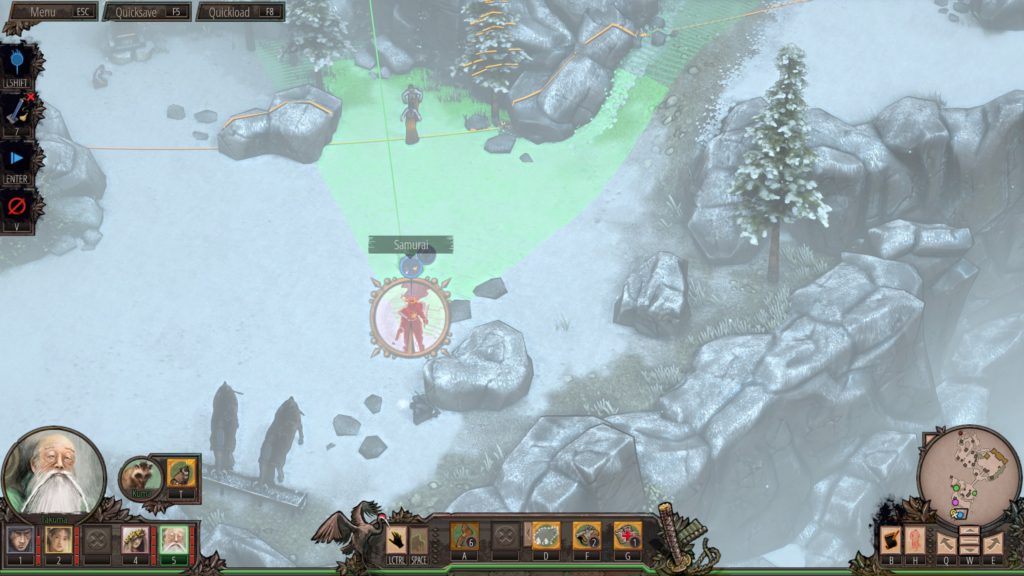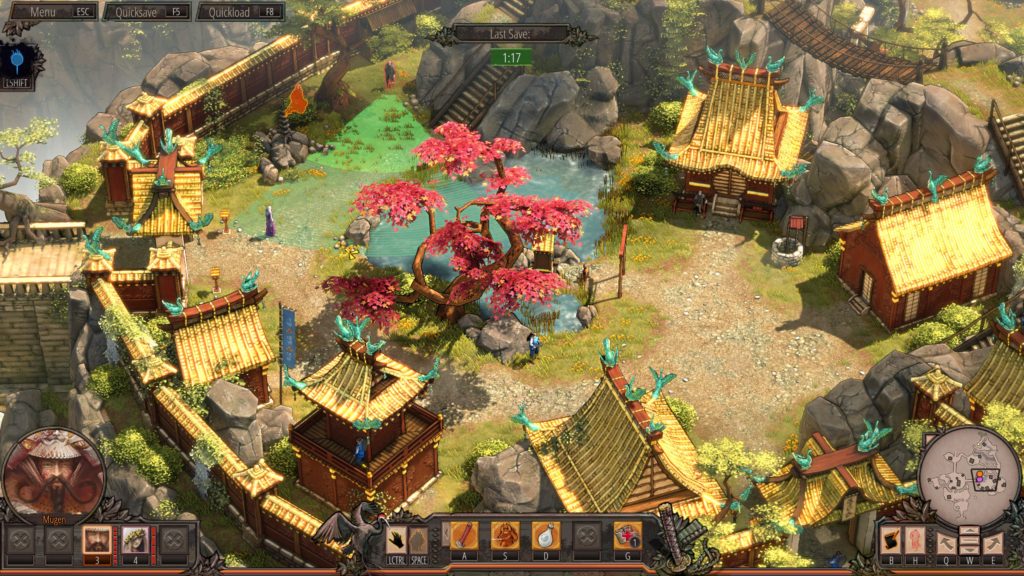
Commandos was one of the series of games that intrigued me but I never got around to playing any of them and now they seem too old to go back to. So along comes developer Mimimi Games who seems intent on single-handedly reviving this never very popular genre. This is described as a stealth-oriented real-time tactics game. It’s stealth as your characters can’t stand up to protracted combat and must rely on quietly taking out guards without alerting others. It’s real-time so there’s no way to pause to consider the situation and issue orders without time pressure. And I suppose it’s tactics because you’ll often need to have your characters work in concert to get past different obstacles and situations.
The story set in ancient Japan is straightforward, involving you leading a team of operatives in support of the shogun’s efforts to destroy a rebellion instigated by the mysterious Kage-sama and uncover his identity. It’s simple and predictable but I like it when the plot doesn’t get in the way of gameplay. The full team consists of five members though you usually won’t get to use everyone in a level. There’s the samurai Mugen, the ninja Hayato, the sniper Takuma, the child thief Yuki and the female ninja Aiko. One might think this is too many as how could you differentiate their abilities enough in a stealth game? But each character is indeed different. Mugen for example is the only character who can kill enemy samurai one-on-one as otherwise you will need two other characters to cooperate to get rid of them. Aiko is a little weak at first but once she gets her hands on a disguise, she can pass freely through most of the level and distract guards like no other character can.

Apart from these special abilities, they also differ in tiny details like how quickly they can kill an enemy, how agile they are and how they can carry around the bodies of dead or unconscious enemies. I feel a little guilty at how often I use little Yuki to kill enemies because she can use her flute ability to draw enemies to her location, kill them with her trap and most of all, slowly drag the corpse to hide elsewhere without ever needing to stand up from a crouching position. Sure, Aiko can also drag enemy bodies like this and Hayato’s ninjato can kill enemies much faster but Aiko can’t draw enemies to her location and Hayato must stand up to carry away corpses even if he moves much faster while doing so. So Yuki it is, allowing her to get away with murder within the tiniest of windows of opportunity.
You better believe that these windows are tight too because the levels are just packed with guards. You’ll often look over the map, and there’s no fog of war here so everything is visible, see the mission objective and think to yourself that you’ll need to get rid of that one guard over there watching it. But then you also notice that that guard is covered by another guard so you won’t be able to kill that first guard without raising an alarm and then see that the second guard is being covered by a third guard and so on in a daisy chain that spirals outwards. It can be surprising how many guards you need to eventually kill to pull off a perfectly stealthy approach. Thanks to tools like being able to see the guards’ cone of vision and being able to put down a marker on the map to check which guards have line of sight to that location, you will quickly notice that the developers have deliberately assembled the levels to give you only the smallest gaps in coverage that you must exploit. It really feels like carefully attacking a large security apparatus piece by piece to slowly take the whole thing down.

As I alluded to above, there are different guard types and different maps even have different mechanics. In maps with snow for example, characters leave footprints behind for a short while after walking on it and guards who see them will follow the prints. Paddy fields provide plenty of cover but walking through puddles of water creates noise. At night, guards can only clearly see a short distance away from them but lighted areas are visible to anyone from a long way away. The missions cover all kinds of terrain and situations including the almost obligatory prison mission where you start out being captured and stripped of all of your nice toys. There are also special object interactions like secret passages, being able to push loose rocks onto enemies underneath and so on but much less than a game like Hitman for example. Still there’s enough variety and content that I couldn’t imagine anyone being disappointed.
This does form one of the few complaints that I have about the game as it feels that there ought to more special or alternate ways to deal with targets. But this approach works too as it forces you to use the basic tools at your disposal in ever more creative ways and within ever tighter constraints. One of the hardest things here is looking at a level and not knowing where to start solving the puzzle as indeed you soon realize that this is a puzzle game. Having special interactions available would just a be big red marker telling you that this is the obvious way to attack the problem. It’s amazing how this game trains you to improve and it might not be obvious until you go back to replay the early levels when you can see how trivial it is to get past the guards.

A more substantial complaint is that the user interface is a little tricky at times. There’s a system for you to queue up actions for characters to execute which is useful when you need them to coordinate but it’s a bit hit and miss as you search for the correct timing through trial and error. Another problem is that some interactions with objects are context sensitive and the mouse pointer has a certain stickiness towards these areas. It can frustrating to know precisely at which point your character is allowed to jump down to a lower level for example. This isn’t a problem if you have the time to move the mouse around to search for the correct spot but try doing that in an emergency as part of series of preplanned actions to deal with an enemy. In general, the game relies on you quick-saving and quick-loading a lot to get through if you really care about not alerting enemies. Then again while the game tracks things the number of civilians you kill and how many times you raised the alarm, that doesn’t stop you from successfully completing the level. It is perfectly okay with you shooting your way through a level if that’s what you want to do so that’s cool too.
The graphics are nothing special and I think the cell-shaded art style even makes this look a little too cartoonish especially when the level takes place in full daylight. But I suppose it helps with clearly distinguishing different types of guards and environmental objects. It does look suitably atmospheric at night and in the snow-covered levels. I also love the little snippets of dialogue between the characters during levels, such as when they express regret about killing soldiers who are supposed to be on the same side.

At one point playing this, I grew immensely frustrated with this game as I felt that the maps look so seemingly simple yet I was taking hours and hours to solve it cleanly. But I soon realized that this is just a measure of how invested I felt in the game and how much I regret how awful I am at playing it. Indeed I found this to be one of the more addictive games I’ve played recently as there is the temptation to spend ever more time analyzing a level to learn what solutions might work. All this is to say that I found myself loving the gameplay here much more than I had expected and I am looking forward to more of the same. The newest one should be the recently released Western-themed Desperados III. I understand that it’s pretty the same experience as this but a more action-oriented approach is made more viable with all of the guns involved here. Sounds great to me!
2 thoughts on “Shadow Tactics: Blade of the Shogun”